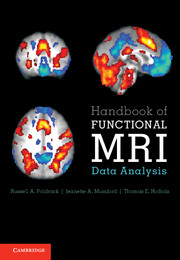Book contents
- Frontmatter
- Contents
- Preface
- 1 Introduction
- 2 Image processing basics
- 3 Preprocessing fMRI data
- 4 Spatial normalization
- 5 Statistical modeling: Single subject analysis
- 6 Statistical modeling: Group analysis
- 7 Statistical inference on images
- 8 Modeling brain connectivity
- 9 Multivoxel pattern analysis and machine learning
- 10 Visualizing, localizing, and reporting fMRI data
- Appendix A A Review of the General Linear Model
- Appendix B Data organization and management
- Appendix C Image formats
- Bibliography
- Index
4 - Spatial normalization
Published online by Cambridge University Press: 01 June 2011
- Frontmatter
- Contents
- Preface
- 1 Introduction
- 2 Image processing basics
- 3 Preprocessing fMRI data
- 4 Spatial normalization
- 5 Statistical modeling: Single subject analysis
- 6 Statistical modeling: Group analysis
- 7 Statistical inference on images
- 8 Modeling brain connectivity
- 9 Multivoxel pattern analysis and machine learning
- 10 Visualizing, localizing, and reporting fMRI data
- Appendix A A Review of the General Linear Model
- Appendix B Data organization and management
- Appendix C Image formats
- Bibliography
- Index
Summary
Introduction
In some cases fMRI data are collected from an individual with the goal of understanding that single person; for example, when fMRI is used to plan surgery to remove a tumor. However, in most cases, we wish to generalize across individuals to make claims about brain function that apply to our species more broadly. This requires that data be integrated across individuals; however, individual brains are highly variable in their size and shape, which requires that they first be transformed so that they are aligned with one another. The process of spatially transforming data into a common space for analysis is known as intersubject registration or spatial normalization.
In this chapter we will assume some familiarity with neuroanatomy; for those without experience in this domain, we discuss a number of useful atlases in Section 10.2. Portions of this chapter were adapted from Devlin & Poldrack (2007).
Anatomical variability
At a gross level, the human brain shows remarkable consistency in its overall structure across individuals, although it can vary widely in its size and shape. With the exception of those suffering genetic disorders of brain development, every human has a brain that has two hemispheres joined by a corpus callosum whose shape diverges relatively little across individuals. A set of major sulcal landmarks (such as the central sulcus, sylvian fissure, and cingulate sulcus) are present in virtually every individual, as are a very consistent set of deep brain structures such as the basal ganglia.
- Type
- Chapter
- Information
- Handbook of Functional MRI Data Analysis , pp. 53 - 69Publisher: Cambridge University PressPrint publication year: 2011
- 1
- Cited by



